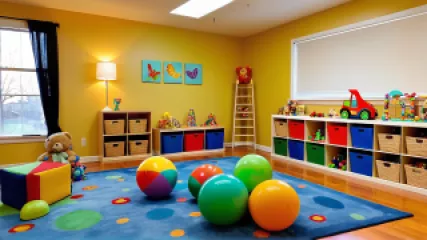Step-by-Step Guide to Implementing Play Therapy for Trauma
Step-by-Step Guide to Implementing Play Therapy for Trauma
As a therapist, you understand the profound impact that trauma can have on a child's emotional and psychological well-being. One of the most effective approaches to helping children heal from trauma is through the power of play therapy. In this comprehensive guide, we'll delve into the world of play therapy, exploring its benefits, principles, and a step-by-step process for implementing it in your practice to support children on their journey to recovery.
Understanding the Importance of Play Therapy for Trauma
Play therapy is a unique and powerful therapeutic approach that harnesses the natural language of children – play. For children who have experienced trauma, play therapy provides a safe and nurturing environment where they can process their experiences, express their emotions, and develop coping mechanisms in a developmentally appropriate way.
Trauma can have a devastating impact on a child's sense of safety, trust, and overall well-being. Traditional talk-based therapies may be less effective for young children, as they often lack the cognitive and verbal skills to articulate their experiences and emotions. Play therapy, on the other hand, allows children to communicate through the universal language of play, unlocking a path to emotional healing and resilience.
The Principles of Play Therapy for Trauma
At the heart of play therapy for trauma lies a set of guiding principles that inform the therapeutic approach. Understanding these principles is crucial for effectively implementing play therapy in your practice.
1. Child-Centered Approach
Play therapy is grounded in a child-centered philosophy, where the child is the primary agent of change. The therapist takes on a non-directive role, allowing the child to lead the play and explore their inner world at their own pace. This empowers the child and fosters a sense of control, which is often diminished in the aftermath of trauma.
2. Therapeutic Relationship
The therapeutic relationship between the child and the therapist is pivotal in play therapy. The therapist creates a safe, nurturing, and empathetic environment where the child feels understood, accepted, and supported. This relationship serves as a foundation for the child to engage in the healing process.
3. Symbolic Expression
Children often lack the verbal skills to articulate their thoughts and feelings, especially when it comes to traumatic experiences. Play therapy allows them to use symbolic expression through toys, art, and imagination to communicate their inner world and process their trauma.
4. Developmental Appropriateness
Play therapy is designed to be developmentally appropriate, catering to the unique needs and abilities of each child. The therapist tailors the therapeutic interventions to the child's age, developmental stage, and specific trauma experiences, ensuring that the process is meaningful and effective.
5. Holistic Approach
Play therapy for trauma adopts a holistic approach, addressing the child's emotional, cognitive, physical, and social needs. The therapist works collaboratively with the child, their family, and other professionals to create a comprehensive treatment plan that supports the child's overall well-being and resilience.
Preparing for Play Therapy: The Initial Assessment
Before you can begin implementing play therapy for trauma, it's essential to conduct a thorough initial assessment. This assessment will help you understand the child's unique needs, their trauma history, and the specific challenges they are facing.
Gather Relevant Information
Start by gathering as much information as possible about the child's background, including their family history, any previous mental health diagnoses, and the details of the traumatic event(s). This information can be obtained through interviews with the child, their caregivers, and any other relevant professionals involved in the child's care.
Assess the Child's Developmental Needs
It's crucial to understand the child's developmental stage and any potential delays or challenges they may be experiencing. This will inform the selection of age-appropriate play therapy materials and techniques. Utilize standardized assessments, observations, and discussions with the child and their caregivers to gain a comprehensive understanding of the child's developmental profile.
Evaluate the Child's Trauma History and Symptoms
Explore the details of the child's trauma history, including the type of trauma experienced, the duration, and the emotional and behavioral impact on the child. Assess the child's current symptoms, such as anxiety, depression, behavioral difficulties, and any signs of post-traumatic stress disorder (PTSD).
Identify Strengths and Protective Factors
While the focus may be on the child's trauma and challenges, it's essential to also identify the child's strengths, resilience, and any protective factors that can be leveraged during the play therapy process. These may include supportive relationships, specific interests or hobbies, and previous coping strategies that have been effective.
Develop a Comprehensive Treatment Plan
Based on the information gathered during the initial assessment, collaborate with the child, their caregivers, and any other relevant professionals to develop a comprehensive treatment plan. This plan should outline the specific goals of play therapy, the therapeutic approach, the frequency and duration of sessions, and any additional support or resources that may be needed.
Implementing Play Therapy for Trauma: A Step-by-Step Guide
Step 1: Create a Safe and Nurturing Environment
The play therapy space should be a safe, comfortable, and inviting environment that fosters a sense of security and trust. Ensure that the room is free from distractions, with age-appropriate toys, art supplies, and other materials that cater to the child's interests and needs.
Establish clear boundaries and rules, and discuss them with the child to help them feel in control and understood. Encourage the child to personalize the space and make it their own, as this can enhance their sense of ownership and engagement in the therapeutic process.
Step 2: Build a Therapeutic Relationship
Developing a strong therapeutic relationship is crucial in play therapy for trauma. As the therapist, your role is to be a calm, empathetic, and non-judgmental presence, allowing the child to feel heard, understood, and accepted.
Engage in active listening, validate the child's feelings, and demonstrate genuine interest in their play and experiences. This helps to build trust, foster emotional safety, and create an environment where the child feels comfortable to explore, express, and process their trauma.
Step 3: Observe and Reflect the Child's Play
Play therapy is a dynamic process, and your role as the therapist is to closely observe the child's play and reflect their experiences back to them. Pay attention to the child's choice of toys, the themes and narratives they explore, and the emotional expression and body language they exhibit during the play.
By reflecting the child's play back to them, you can help them to gain a deeper understanding of their own thoughts, feelings, and behaviors, and to gradually make connections between their play and their traumatic experiences.
Step 4: Incorporate Trauma-Focused Interventions
While play therapy is a non-directive approach, there are specific trauma-focused interventions that can be incorporated to support the child's healing process. These may include:
- Storytelling and Narrative Therapy: Encouraging the child to create stories or narratives that reflect their trauma experiences, allowing them to process and make sense of their experiences in a safe and creative way.
- Art and Sand Tray Therapy: Providing art materials and sand trays that allow the child to express and symbolize their trauma through visual and kinesthetic means.
- Role-Playing and Puppetry: Engaging the child in role-play or using puppets to act out scenarios related to their trauma, helping them to explore different perspectives and coping strategies.
- Relaxation and Grounding Techniques: Teaching the child calming and self-regulation strategies, such as deep breathing, visualization, or progressive muscle relaxation, to help manage trauma-related anxiety and emotions.
The specific interventions used will depend on the child's age, developmental stage, and the nature of their trauma experiences. Collaborate with the child to determine which approaches resonate with them and tailored to their unique needs.
Step 5: Involve Caregivers and Collaborate with Other Professionals
Play therapy for trauma is most effective when it is part of a comprehensive, collaborative approach that involves the child's caregivers and other professionals involved in their care. Regularly communicate with the child's caregivers, sharing updates, progress, and any areas of concern.
Encourage caregiver involvement by providing them with play-based activities and strategies to implement at home, reinforcing the therapeutic work and supporting the child's overall healing. Additionally, collaborate with other professionals, such as pediatricians, social workers, or school counselors, to ensure a holistic and coordinated approach to the child's well-being.
Step 6: Assess and Adjust the Therapeutic Approach
Regularly evaluate the progress of the play therapy sessions and the child's overall well-being. Utilize standardized assessments, observations, and feedback from the child and their caregivers to measure the effectiveness of the therapeutic interventions and make necessary adjustments to the treatment plan.
Be prepared to adapt your approach as the child's needs and progress evolve. Flexibility and a willingness to try different techniques are key to ensuring the play therapy process remains responsive and effective in supporting the child's healing and growth.
Sustaining the Healing Journey: Continued Support and Aftercare
The play therapy process for trauma is not a linear journey; it often involves ups and downs, setbacks, and periods of emotional growth. As the therapist, it's crucial to provide continued support and aftercare to ensure the child's healing is sustained long-term.
This may include:
- Gradual tapering of play therapy sessions, with a focus on developing the child's self-regulation and coping skills
- Ongoing collaboration with caregivers and other professionals to reinforce the therapeutic work and address any emerging challenges
- Referrals to additional support services, such as support groups or community-based resources, to foster a wider network of care
- Periodic check-ins and booster sessions to provide continuity of care and address any resurgence of trauma-related symptoms
By prioritizing continued support and aftercare, you can help the child and their family navigate the ups and downs of the healing journey, empowering them to maintain the progress made through play therapy and build a foundation for long-term resilience.
Embracing the Power of Play Therapy for Trauma
Play therapy is a transformative approach that holds immense potential for supporting children who have experienced trauma. By understanding the principles of play therapy, conducting a thorough initial assessment, and implementing a step-by-step process tailored to the child's unique needs, you can unlock the power of play to facilitate emotional healing, foster resilience, and help children reclaim their sense of safety, trust, and well-being.
As you embark on this journey with your young clients, remember that the play therapy process is not just about techniques and interventions; it's about creating a nurturing, empathetic, and collaborative space where the child can feel heard, understood, and empowered to navigate their trauma and reclaim their childhood. With patience, flexibility, and a deep commitment to the child's well-being, you can transform lives and help children build the foundation for a brighter future.
About the Author
Hal Armstrong is a licensed clinical psychologist with over 15 years of experience in the field of child and adolescent mental health. Hal has dedicated his career to supporting children and families who have experienced trauma, with a particular focus on implementing play therapy as a key therapeutic approach. He is the co-founder of the Institute for Play Therapy and Trauma Recovery, where he trains other mental health professionals in the art and science of play therapy.
Hal's passion for play therapy stems from his belief in the inherent resilience and healing potential of children. He has witnessed firsthand the transformative power of play, as it allows young clients to process their experiences, develop coping strategies, and reclaim their sense of safety and well-being. Hal's expertise in trauma-informed care, coupled with his deep understanding of child development, makes him a sought-after expert in the field of play therapy for trauma.
When he's not in the therapy room, Hal can be found spending time in nature, practicing mindfulness, and engaging in creative pursuits. He is a firm believer in the importance of self-care and often encourages his clients and colleagues to embrace the restorative powers of play and creativity in their own lives.






